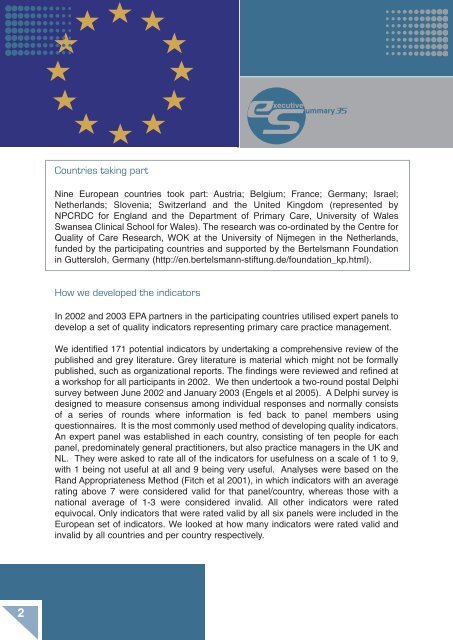(EPA): Quality management in primary care (Executive Summary 35)
(EPA): Quality management in primary care (Executive Summary 35)
(EPA): Quality management in primary care (Executive Summary 35)
Create successful ePaper yourself
Turn your PDF publications into a flip-book with our unique Google optimized e-Paper software.
2<br />
Countries tak<strong>in</strong>g part<br />
esxecutive ummary<br />
N<strong>in</strong>e European countries took part: Austria; Belgium; France; Germany; Israel;<br />
Netherlands; Slovenia; Switzerland and the United K<strong>in</strong>gdom (represented by<br />
NPCRDC for England and the Department of Primary Care, University of Wales<br />
Swansea Cl<strong>in</strong>ical School for Wales). The research was co-ord<strong>in</strong>ated by the Centre for<br />
<strong>Quality</strong> of Care Research, WOK at the University of Nijmegen <strong>in</strong> the Netherlands,<br />
funded by the participat<strong>in</strong>g countries and supported by the Bertelsmann Foundation<br />
<strong>in</strong> Guttersloh, Germany (http://en.bertelsmann-stiftung.de/foundation_kp.html).<br />
How we developed the <strong>in</strong>dicators<br />
In 2002 and 2003 <strong>EPA</strong> partners <strong>in</strong> the participat<strong>in</strong>g countries utilised expert panels to<br />
develop a set of quality <strong>in</strong>dicators represent<strong>in</strong>g <strong>primary</strong> <strong>care</strong> practice <strong>management</strong>.<br />
We identified 171 potential <strong>in</strong>dicators by undertak<strong>in</strong>g a comprehensive review of the<br />
published and grey literature. Grey literature is material which might not be formally<br />
published, such as organizational reports. The f<strong>in</strong>d<strong>in</strong>gs were reviewed and ref<strong>in</strong>ed at<br />
a workshop for all participants <strong>in</strong> 2002. We then undertook a two-round postal Delphi<br />
survey between June 2002 and January 2003 (Engels et al 2005). A Delphi survey is<br />
designed to measure consensus among <strong>in</strong>dividual responses and normally consists<br />
of a series of rounds where <strong>in</strong>formation is fed back to panel members us<strong>in</strong>g<br />
questionnaires. It is the most commonly used method of develop<strong>in</strong>g quality <strong>in</strong>dicators.<br />
An expert panel was established <strong>in</strong> each country, consist<strong>in</strong>g of ten people for each<br />
panel, predom<strong>in</strong>ately general practitioners, but also practice managers <strong>in</strong> the UK and<br />
NL. They were asked to rate all of the <strong>in</strong>dicators for usefulness on a scale of 1 to 9,<br />
with 1 be<strong>in</strong>g not useful at all and 9 be<strong>in</strong>g very useful. Analyses were based on the<br />
Rand Appropriateness Method (Fitch et al 2001), <strong>in</strong> which <strong>in</strong>dicators with an average<br />
rat<strong>in</strong>g above 7 were considered valid for that panel/country, whereas those with a<br />
national average of 1-3 were considered <strong>in</strong>valid. All other <strong>in</strong>dicators were rated<br />
equivocal. Only <strong>in</strong>dicators that were rated valid by all six panels were <strong>in</strong>cluded <strong>in</strong> the<br />
European set of <strong>in</strong>dicators. We looked at how many <strong>in</strong>dicators were rated valid and<br />
<strong>in</strong>valid by all countries and per country respectively.<br />
<strong>35</strong>


